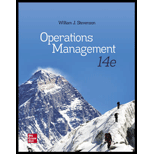
EBK OPERATIONS MANAGEMENT
14th Edition
ISBN: 9781260718447
Author: Stevenson
Publisher: MCG COURSE
expand_more
expand_more
format_list_bulleted
Concept explainers
Question
Chapter 18, Problem 13P
a)
Summary Introduction
To determine: Whether the third crew member will be economical.
b.
Summary Introduction
To determine: Would the fourth member be justifiable.
Expert Solution & Answer
Want to see the full answer?
Check out a sample textbook solution
Students have asked these similar questions
How much does self-awareness influence the Interpersonal Trust Scale's results?
Which of the following statements about organization's strategy is FALSE?
OA. They are formulated after the organization's mission is determined.
OB. They reflect an organization's purpose.
OC. An organization's strategy exploits opportunities and threats.
OD. They help determine how an organization expects to achieve its miss
OE. Each functional area of the organization will have a strategy.
The ability of an organization to match changes in a marketplace where design
volumes fluctuate substantially is:
OA. competing on productivity.
OB. mass production.
OC. time-based competition.
OD. competing on differentiation.
O E. competing on response.
Porter's Five Forces Model is used to evaluate competition based on which 5 asp
A. immediate rivals, potential entrants, customers, suppliers, and substitute
B. potential entrants, customers, suppliers, legal regulations, and cost
please answer
Chapter 18 Solutions
EBK OPERATIONS MANAGEMENT
Ch. 18.1 - Prob. 1.1RQCh. 18.1 - Prob. 1.2RQCh. 18 - Prob. 1DRQCh. 18 - Why do waiting lines form even though a service...Ch. 18 - Prob. 3DRQCh. 18 - Prob. 4DRQCh. 18 - What approaches do supermarkets use to offset...Ch. 18 - Prob. 6DRQCh. 18 - Prob. 7DRQCh. 18 - Prob. 8DRQ
Ch. 18 - Prob. 9DRQCh. 18 - Prob. 1TSCh. 18 - Prob. 2TSCh. 18 - Prob. 3TSCh. 18 - Prob. 1CTECh. 18 - Prob. 2CTECh. 18 - Prob. 3CTECh. 18 - The owner of Eat Now Restaurant implemented an...Ch. 18 - Prob. 5CTECh. 18 - Prob. 1PCh. 18 - Prob. 2PCh. 18 - Prob. 3PCh. 18 - Prob. 4PCh. 18 - Prob. 5PCh. 18 - Prob. 6PCh. 18 - Prob. 7PCh. 18 - Prob. 8PCh. 18 - Prob. 9PCh. 18 - Prob. 10PCh. 18 - Prob. 11PCh. 18 - Prob. 12PCh. 18 - Prob. 13PCh. 18 - Prob. 14PCh. 18 - Prob. 15PCh. 18 - A priority waiting system assigns arriving...Ch. 18 - Prob. 17PCh. 18 - Prob. 18PCh. 18 - Prob. 1CQ
Knowledge Booster
Learn more about
Need a deep-dive on the concept behind this application? Look no further. Learn more about this topic, operations-management and related others by exploring similar questions and additional content below.Similar questions
- In the 2016, "ATB: digital disruption in the parking meter industry" perform a finanacial analysis and make a chart similar to this one 2013 2014 Current Ratio 1.88 1.41 Quick Ratio 0.49 0.29 Debt to Equity 0.95 1.92 Return on Assets 5.47% 2.76% Net Profit Margin 2.71% 1.89%arrow_forwardPerform a VRIO Analysis on the 2016 "ATB: Digital disruption in the parking meter industry" and make a chart similar to this one V R I O Topic Y Y Y Y Relations with John Deere and Paccar Y N N Y Customer Relations Y Y Y Y Acquisition and Integration Process Y Y Y N Cervus Leadership University Y Y N Y Proactive Management Y Y N Y Financial Position Y N N N Scale of Organizationarrow_forwardHow do incorporated stress management techniques impact future emotional strength and wellness? What are the lesson learned from incorporating stress management techniques in the past that reflects developing emotional resilience?arrow_forward
arrow_back_ios
SEE MORE QUESTIONS
arrow_forward_ios
Recommended textbooks for you
 Practical Management ScienceOperations ManagementISBN:9781337406659Author:WINSTON, Wayne L.Publisher:Cengage,MarketingMarketingISBN:9780357033791Author:Pride, William MPublisher:South Western Educational Publishing
Practical Management ScienceOperations ManagementISBN:9781337406659Author:WINSTON, Wayne L.Publisher:Cengage,MarketingMarketingISBN:9780357033791Author:Pride, William MPublisher:South Western Educational Publishing

Practical Management Science
Operations Management
ISBN:9781337406659
Author:WINSTON, Wayne L.
Publisher:Cengage,

Marketing
Marketing
ISBN:9780357033791
Author:Pride, William M
Publisher:South Western Educational Publishing
